|
|
St George the Confessor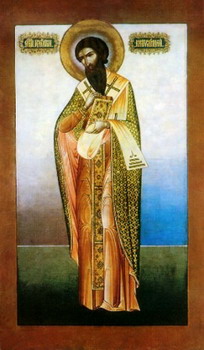 For his great virtues, which he acquired through long asceticism, George was chosen and installed as Metropolitan of Mitylene. And this saint governed his flock with zeal and wisdom to old age. But when a persecution arose under Leo V, the Armenian, who destroyed the holy icons, this holy elder was summoned by the Emperor to Constantinople, to the Council of bishops which was summoned, at the Emperor's desire, to put a stop to the veneration of icons. But George not only refused to act according to the Emperor's desire; he, together with some other courageous bishops, stood up in defence of the holy icons. For this he was held in derision by the Emperor and exiled to the region of Cherson, where, in physical pain and every sort of need, he spent the remainder of his earthly life. He died and went to immortal life in about 816. He was a wonderworker both during his life and after his death, through his great righteousness and love for the Lord Jesus. For his great virtues, which he acquired through long asceticism, George was chosen and installed as Metropolitan of Mitylene. And this saint governed his flock with zeal and wisdom to old age. But when a persecution arose under Leo V, the Armenian, who destroyed the holy icons, this holy elder was summoned by the Emperor to Constantinople, to the Council of bishops which was summoned, at the Emperor's desire, to put a stop to the veneration of icons. But George not only refused to act according to the Emperor's desire; he, together with some other courageous bishops, stood up in defence of the holy icons. For this he was held in derision by the Emperor and exiled to the region of Cherson, where, in physical pain and every sort of need, he spent the remainder of his earthly life. He died and went to immortal life in about 816. He was a wonderworker both during his life and after his death, through his great righteousness and love for the Lord Jesus.Our Holy Father Nil Sorsky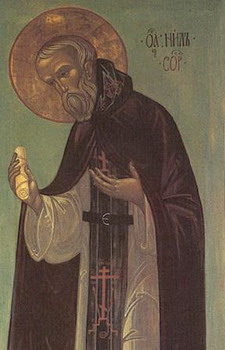 One of the great fathers of the Russian Church, he was the founder of the monastic 'skete' way of life in Russia. He died peacefully in 1508, and his relics are preserved in the monastery at Sora. His rule of life in the sketes presents a spiritual and pragmatic work of the first order One of the great fathers of the Russian Church, he was the founder of the monastic 'skete' way of life in Russia. He died peacefully in 1508, and his relics are preserved in the monastery at Sora. His rule of life in the sketes presents a spiritual and pragmatic work of the first orderThe Holy Martyr Calliopus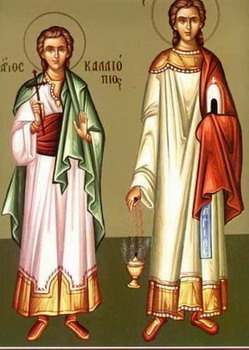 The only son, obtained from God with tears, of a senator of Perga in Pamphylia. His devout mother, Theoclea, taught him veneration of God and purity of life at an early age. Calliopus was still very young when a terrible persecution arose under the Emperor Maximian. To save him from death, his mother put him into a ship, gave him a sufficient sum of money and sent him off to the city of Pompeiopolis. But things turned out differently, by the providence of God. Disembarking at Pompeiopolis, Calliopus walked straight into some tumultuous pantheistic celebration. When he, in the press of the crazed mob, refused to take part in that senseless feast, he was brought to the commander, Maximus, to whom he confessed that he was a Christian. The commander ordered that he be beaten with iron staves, burned by fire and finally, wounded all over, thrown into prison. Hearing of the torture of her son, his mother Theoclea gave away all her goods to the poor and needy and, with a small sum of money, hurried to her son's prison. Entering the prison, she bowed to her son and bound up his wounds. Finally, the commander pronounced the sentence that Calliopus be crucified. Joy and anguish were mingled together in his mother's heart. When they led her son to the place of execution, she passed the executioner five gold pieces to crucify her son, not like the Lord, but upside-down. This she did from humility towards the Lord. Calliopus was crucified, upside-down, on Holy Thursday, and his mother stood below the cross giving thanks to God. When they took his dead body down from the cross the next day, she fell on it and breathed her last. Thus these two went to stand before the throne of the King of glory. They suffered with honour in 304. The only son, obtained from God with tears, of a senator of Perga in Pamphylia. His devout mother, Theoclea, taught him veneration of God and purity of life at an early age. Calliopus was still very young when a terrible persecution arose under the Emperor Maximian. To save him from death, his mother put him into a ship, gave him a sufficient sum of money and sent him off to the city of Pompeiopolis. But things turned out differently, by the providence of God. Disembarking at Pompeiopolis, Calliopus walked straight into some tumultuous pantheistic celebration. When he, in the press of the crazed mob, refused to take part in that senseless feast, he was brought to the commander, Maximus, to whom he confessed that he was a Christian. The commander ordered that he be beaten with iron staves, burned by fire and finally, wounded all over, thrown into prison. Hearing of the torture of her son, his mother Theoclea gave away all her goods to the poor and needy and, with a small sum of money, hurried to her son's prison. Entering the prison, she bowed to her son and bound up his wounds. Finally, the commander pronounced the sentence that Calliopus be crucified. Joy and anguish were mingled together in his mother's heart. When they led her son to the place of execution, she passed the executioner five gold pieces to crucify her son, not like the Lord, but upside-down. This she did from humility towards the Lord. Calliopus was crucified, upside-down, on Holy Thursday, and his mother stood below the cross giving thanks to God. When they took his dead body down from the cross the next day, she fell on it and breathed her last. Thus these two went to stand before the throne of the King of glory. They suffered with honour in 304.Our Holy Father Daniel of Pereyaslavi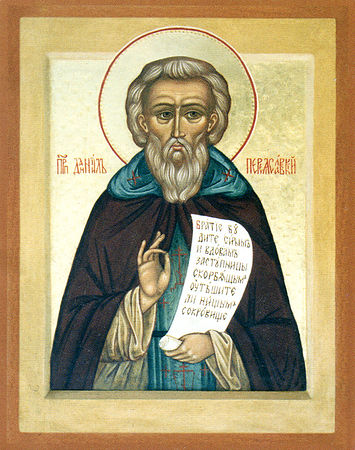 He had as his special asceticism the care of the dead. Whenever he heard that someone had frozen to death or died in some other way, he hurried to give him burial and to pray to God for him. He died peacefully in 1540. His healing relics are preserved to this day. He had as his special asceticism the care of the dead. Whenever he heard that someone had frozen to death or died in some other way, he hurried to give him burial and to pray to God for him. He died peacefully in 1540. His healing relics are preserved to this day.Our Holy Father Gregory the SinaiteA great saint and ascetic of Sinai and Athos (see August 8th).
Martyrs Rufinus deacon, Aquilina, and 200 soldiers at Sinope (310)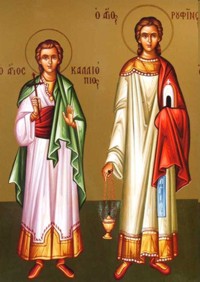 The Holy Martyr Rufinus the Deacon, the Martyress Acelina and with them 200 Soldiers suffered in about the year 310 in the city of Sinope on the Black Sea during the reign of the emperor Maximian (305-311). When the holy deacon Rufinus was put into prison for confessing the Christian faith, the martyress Acelina showed concern. For this she was also placed under guard. In prison they converted to Christ by their miracles 200 soldiers, and all of them together were beheaded by the sword. The Holy Martyr Rufinus the Deacon, the Martyress Acelina and with them 200 Soldiers suffered in about the year 310 in the city of Sinope on the Black Sea during the reign of the emperor Maximian (305-311). When the holy deacon Rufinus was put into prison for confessing the Christian faith, the martyress Acelina showed concern. For this she was also placed under guard. In prison they converted to Christ by their miracles 200 soldiers, and all of them together were beheaded by the sword.Venerable Leucius, abbot of Volokolamsk (1492)
|